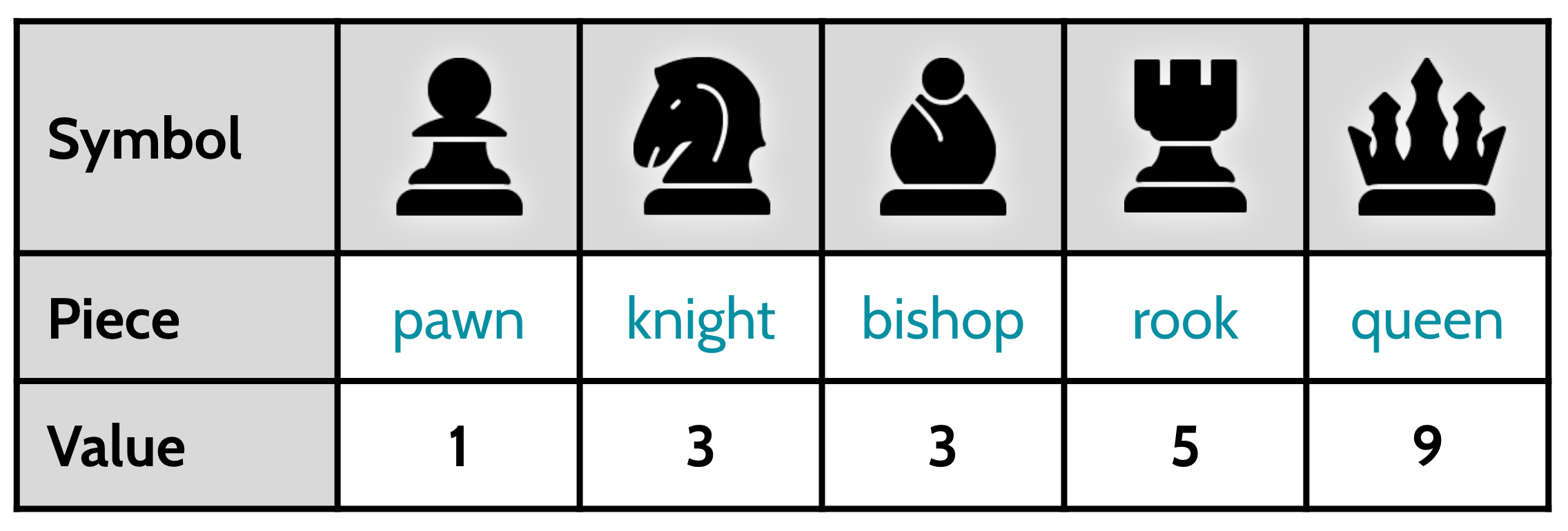The relative value assigned to each piece in chess, with pawns being worth 1 point, bishops and knights 3 points, rooks 5 points, and queens 9 points.

Introduction
In chess, piece value is a fundamental concept that helps players evaluate positions, trade pieces wisely, and make strategic decisions. Each piece has an assigned value based on its relative strength and mobility. However, these values are not absolute—they change depending on position, coordination, and game phase.
What are the standard values of chess pieces? How do these values influence decision-making? And when do these values become flexible? This article explores the classic point system, its strategic importance, and how strong players use piece value to gain an advantage.
1. The Standard Chess Piece Values
Each piece in chess is assigned a relative value, representing its power in typical positions.
The Traditional Point System:
- Pawn (♙) = 1 point
- Knight (♘) = 3 points
- Bishop (♗) = 3 points
- Rook (♖) = 5 points
- Queen (♕) = 9 points
- King (♔) = Priceless (since checkmate ends the game)
This system provides a general guideline for evaluating trades, such as:
- Trading a bishop for a knight (both valued at 3) is considered equal.
- Trading a rook (5) for two minor pieces (bishop + knight = 6) often favors the side gaining two pieces.
- Losing a queen (9) for a rook and minor piece (5+3=8) is usually unfavorable.
2. Why These Values Matter
Evaluating Trades
Understanding piece values helps players decide whether an exchange benefits them. For example:
- Is capturing a bishop with your knight worth it?
- Should you sacrifice a rook to expose the opponent’s king?
Material Imbalances
A position with imbalanced material (e.g., a queen vs. two rooks) requires deeper evaluation beyond simple arithmetic. In open positions, rooks often outperform a queen, while in closed positions, the queen’s mobility may dominate.
Positional vs. Tactical Value
While numerical values provide a starting point, chess is not just about numbers. Position, activity, and coordination often outweigh material count.
3. Adjustments to Piece Values
The Bishop vs. Knight Debate
Though both bishops and knights are valued at 3 points, their strengths vary based on position:
- Bishops are stronger in open positions because of their long-range mobility.
- Knights are better in closed positions, as they can jump over pieces.
Some modern evaluations assign:
- Bishop = 3.25 or 3.5 points (slightly better than a knight)
- Knight = 3 points, but its strength increases in tight positions.
The Bishop Pair
A pair of bishops is often more powerful than two knights because they can control both light and dark squares. This advantage can increase their combined value to around 7 points (instead of 6).
Rook Activity and King Safety
A rook is normally 5 points, but an inactive rook (trapped on its first rank) may be worth far less. Meanwhile, a powerful, open-file rook might play at a much stronger level.
The King in the Endgame
During the middle game, the king is a liability, needing protection. But in endgames, an active king acts like a strong piece, sometimes valued at 4 points due to its ability to control squares and support pawn promotion.
4. Special Situations Where Piece Values Change
Pawn Promotion
A simple pawn (1 point) can turn into a queen (9 points) through promotion, drastically changing the game.
The Exchange Sacrifice
Sometimes, sacrificing a rook (5 points) for a knight or bishop (3 points) can be strategically justified if it:
- Weakens the opponent’s pawn structure
- Gains long-term positional compensation
- Activates other pieces (e.g., a powerful bishop or queen)
Piece Coordination
A pair of knights or bishops working together can be stronger than their numerical values suggest. Piece harmony and mobility are crucial.
Dynamic vs. Static Advantages
Some positions favor dynamic advantages (e.g., activity, open lines), where sacrificing material is justified. Other positions favor static advantages (e.g., extra pawns), where keeping material is more beneficial.
5. Conclusion
While the standard piece value system provides a useful guide for evaluating trades, strong chess players understand that piece activity, coordination, and position often outweigh raw numerical values. Mastering the art of when to exchange, when to sacrifice, and how to maximize piece power is essential for improving at chess.
By thinking beyond numbers and evaluating position-specific factors, players can develop a deeper understanding of chess strategy and make better decisions at the board.

